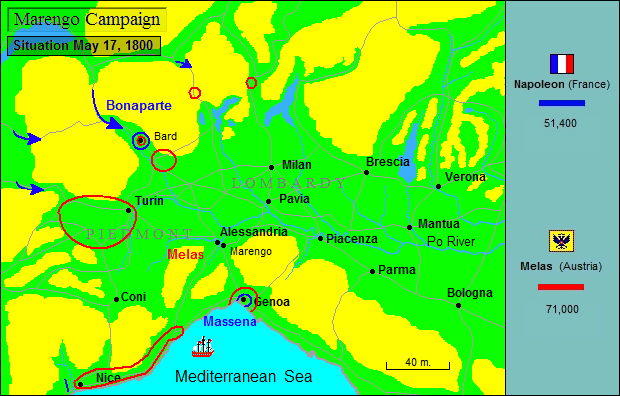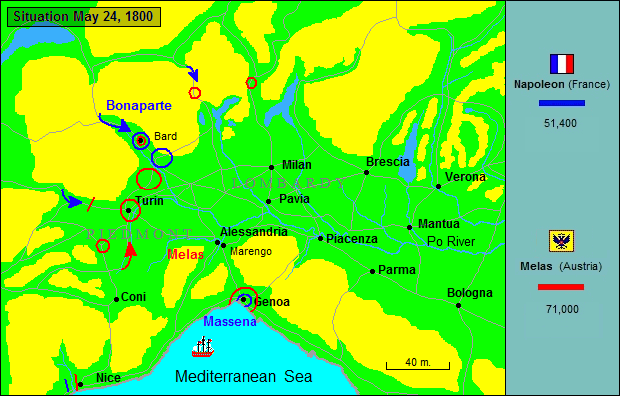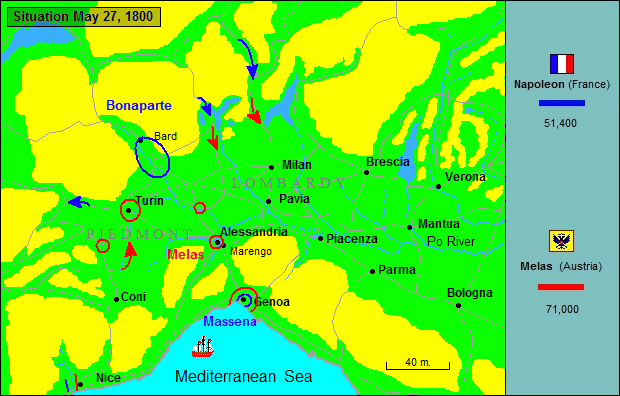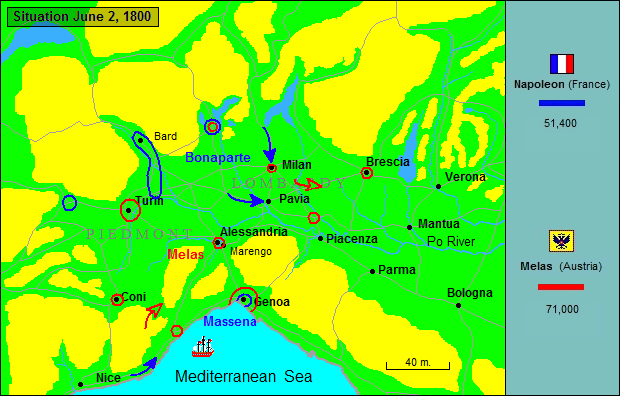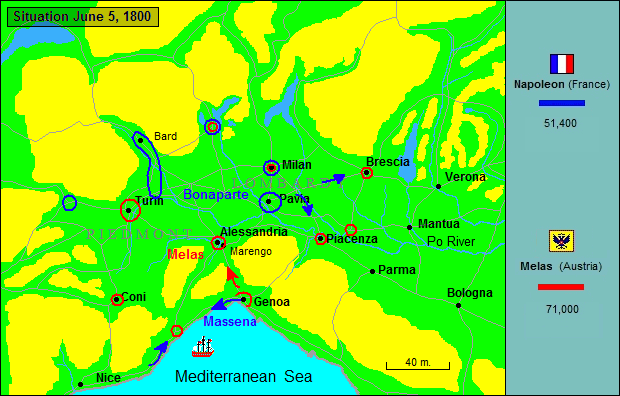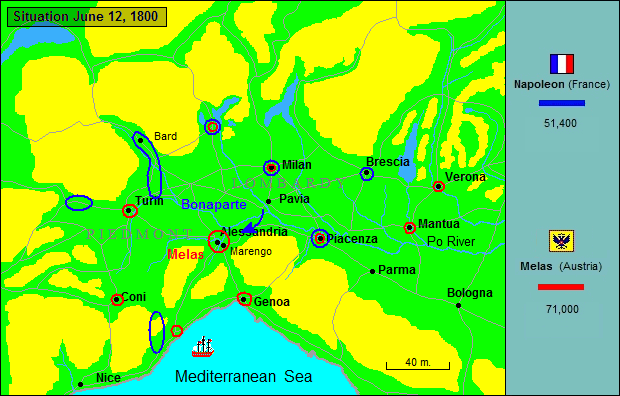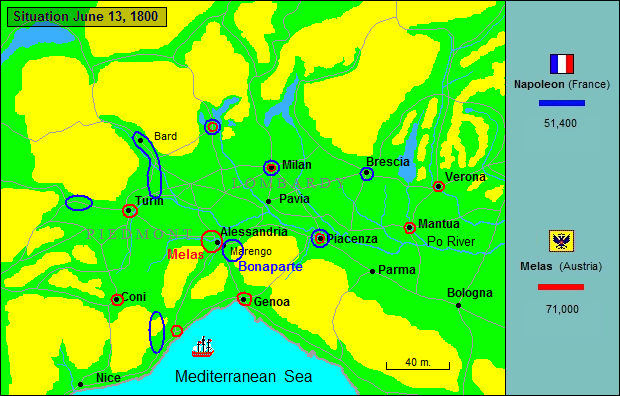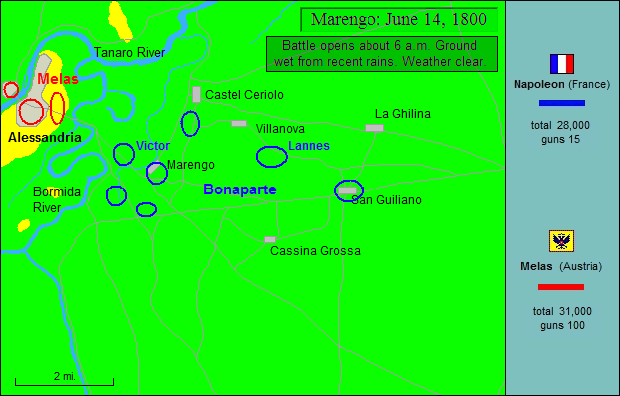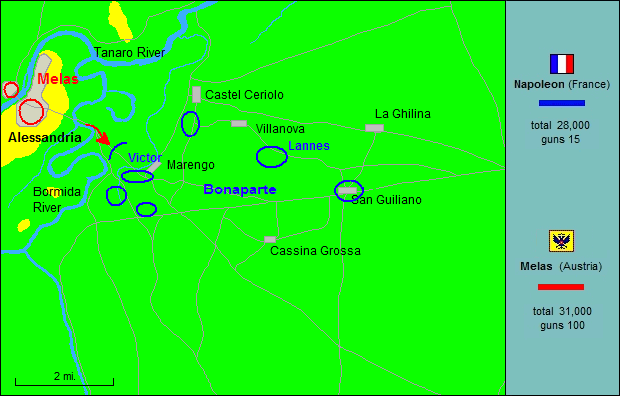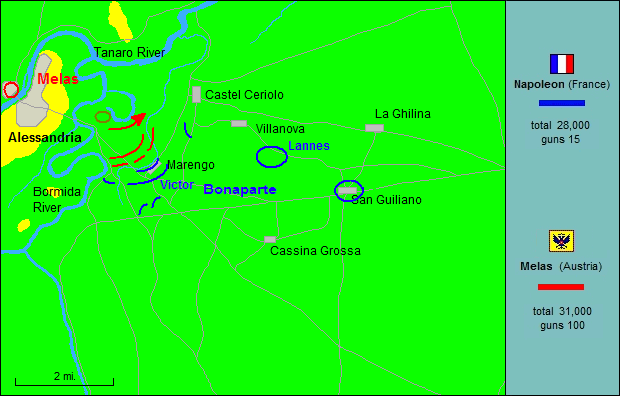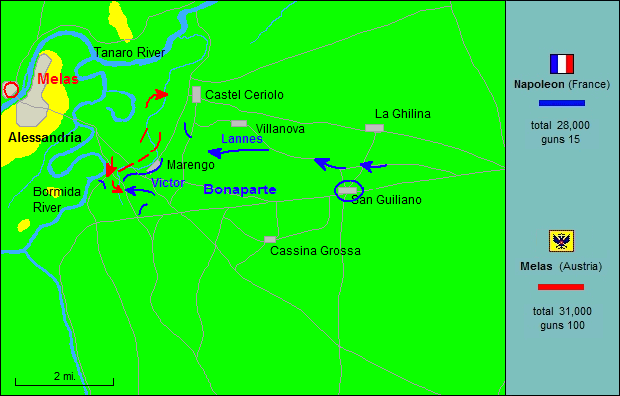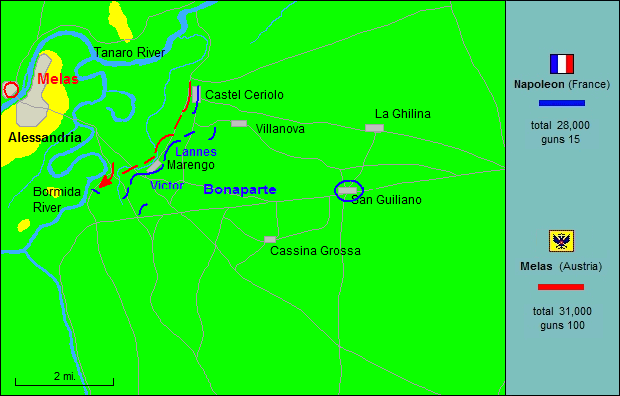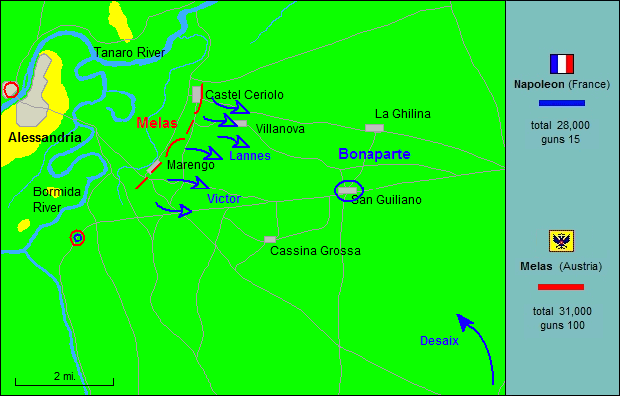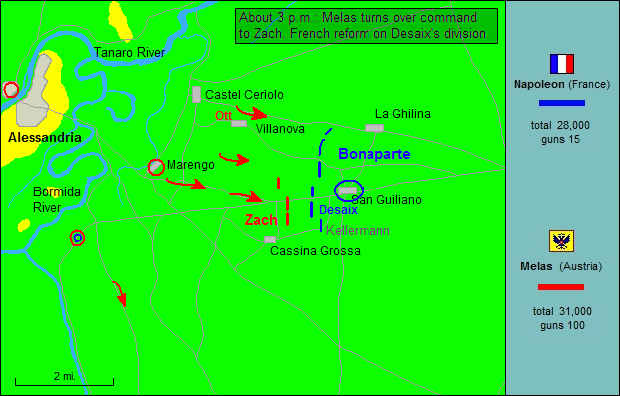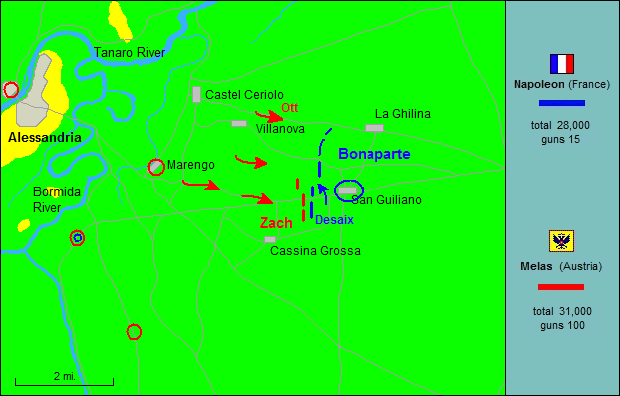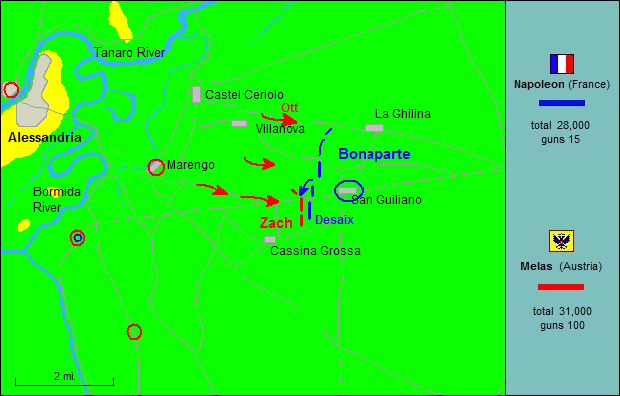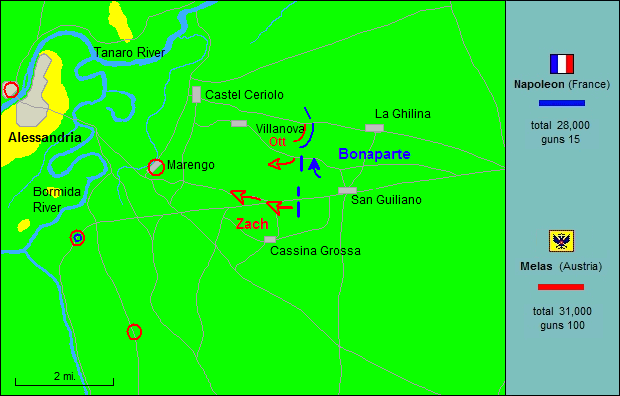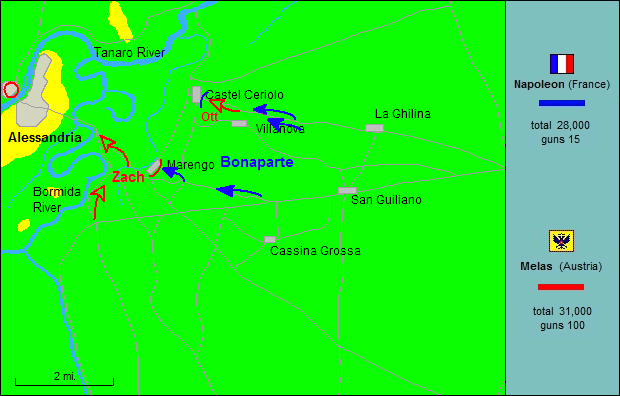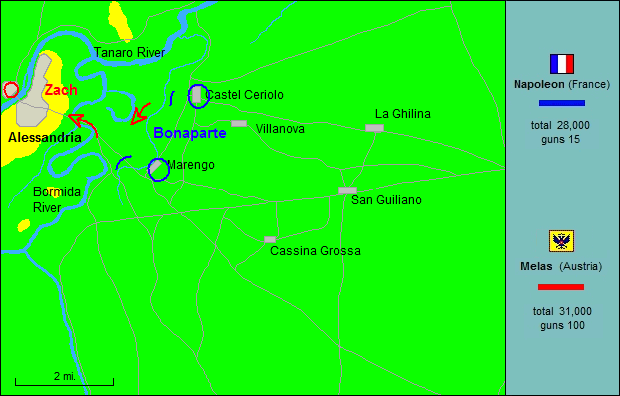By the time Napoleon assumed political power in the coup d’etat of 19 Brumaire, France had been at war with a coalition of European monarchies for over a year (War of the Second Coalition), during which much of the territorial gains he had achieved in the Italian Campaign had been erased. Eager to avenge their earlier losses, the Austrians had assembled an army of 128,000 men under the hard-fighting Michael Melas and were well on their way to recovering virtually all of their former territory in Lombardy and Piedmont. Facing this massive presence in and around Genoa was an army of 36,000 hard-used, ill-fed and ragged French troops under André Masséna, a wily veteran of the Italian Campaign. Meanwhile, the largest of the French armies, more than 100,000 men commanded by General Moreau, was situated along the upper Rhine, confronting a slightly larger Austrian force under Baron Kray. Strategically located between these two fronts and in a position to support either was the newly-gathered Reserve Army at Dijon. Uncertain in which direction to advance, First Consul Bonaparte had deliberately left his options open.
His uncertainty came to an end in April 1800, when Melas went on the attack, isolating Massena’s army in Genoa and threatening to starve it into submission. In response, Napoleon planned a counter-stroke in which the Reserve Army would march through the high passes of the Alps and descend on Melas’ army from the north. Though moving large masses of men and equipment through the snow-bound mountain passes presented a daunting challenge in itself, if successful the plan promised to restore much of northern Italy at a single blow. (In addition, the feat promised to recall Hannibal’s legendary crossing of the Alps during the Second Punic War, a comparison that scarcely offended Napoleon’s sense of destiny.) Ordering Massena to hold Genoa and thereby tie up the greater part of Melas’ force, Napoleon determined on a primary route from the vicinity of Geneva through the Great St. Bernard Pass, and on 1 May the arduous crossing began. Meanwhile, outlying detachments advanced along the nearby Simplon and Gothard passes, creating a kind of shell game by which to confuse the enemy. By 19 May the bulk of the army had made its way across the Great St. Bernard, running up against the first enemy resistance at Fort Bard, an all-but-impregnable stronghold on the southern slope of the range. Resorting to nearby mountain paths, the French vanguard was able to circumvent the obstacle and proceed to Ivrea, at which point it turned eastward, toward Milan. Surrounding the city on 2 June, Napoleon pressed southward to close the door on any enemy forces attempting to escape down the valley of the Po.
Having initially concentrated his forces in the vicinity of Turin, Melas responded to the French incursion by shifting eastward to cover his line of communication. With Massena’s isolated force on the verge of capitulation in Genoa, however, Melas refused to withdraw down the Po, seeking instead to hold his ground in Piedmont. His decision was affirmed on 4 June, when Massena was compelled to surrender, enabling Austrian coastal forces to join the main army at the fortified town of Alessandria. At this point, though their communications along the Po had been cut, the Austrians were in a position to retire, if necessary, upon Genoa, where they could enlist the aid of the Royal Navy.
Determined to prevent this, Napoleon pressed forward, hoping to cut them off and bring on a major battle in open country. About this time (11 June) General Desaix arrived in the French camp at the end of a long and perilous journey from Egypt. In recognition of the general’s brilliant pursuit of his Egyptian foe, Murad Bey, arrangements had been made for his return, and upon his arrival a newly-organized corps was placed under his command. Approaching Alessandria from the east on the 12th, Napoleon recognized in the broad plain surrounding the town of Marengo a likely field upon which the Austrians might seek to deploy their cavalry, yet despite isolated reports of enemy activity there was no clear indication of the whereabouts of Melas’ main force. The question lingered throughout the next day, causing increasing concern until, fearful that Melas might escape to the south, Napoleon ordered generals Lannes and Victor to advance their corps as far as Marengo, holding Desaix’s troops in reserve along the road to Genoa. As night fell, the last of a series of rain showers made encampment difficult for the French, and as a result, few defensive precautions were taken. The omission would not be without consequence.
About 6 a.m. on 14 June 1800 the Austrians began marching out of Alessandria, filing over a series of bridges across the Bormida River and advancing upon Marengo. Though the oncoming enemy took the French largely by surprise, the men of Victor’s corps made a stubborn defense of the town, holding up the Austrian advance long enough to allow Lannes’ troops to come into line on their right. Even as the fighting in Marengo grew more heated, however, Napoleon made little effort to bring up reinforcements, convinced that the attack was merely a feint designed to cover Melas’ escape to the south with the bulk of his army. Thus, despite reports that the enemy was advancing upon Marengo in force, he sent orders for Desaix to march south to Novi, some ten miles away, while General Lapoype was ordered north to cover any escape down the Po. Luckily for the French, difficulties in crossing the rain-swollen Scrivia River held up Desaix’s advance, and as the morning wore on the increasing thunder of guns in the direction of Marengo gave the general pause. Having sent a cavalry attachment ahead to confirm the absence of enemy forces in Novi, Desaix was loath to continue his march in stark contradiction of a central tenet of warfare–always march toward, not away from, the sound of the guns.
Back in Marengo, Victor’s corps had succeeded in repelling the initial Austrian assault only to discover fresh enemy battle lines advancing upon their position as Austrian artillery continued to take a heavy toll. With Lannes’ corps fully committed and French reserves far from the field, the situation was growing more critical by the moment. At this point, Napoleon–who thus far had stuck tenaciously to his own over-wrought interpretation of events–rode forward to survey the fighting and realized his mistake. Suddenly alive to the presence of Melas’ main army and his own strategic vulnerability, he ordered all uncommitted troops forward and sent messages for Desaix and Lapoype to return at once. It was nearly ten o’clock.
Meanwhile, the Austrians continued to batter away at the two French corps defending the town. Though Melas’ advance had not been particularly well-orchestrated, it was nonetheless deliberate, and as the main attack pressed across Fontanone Creek, a flanking force was ordered forward to occupy the village of Castel Ceriola. Their objective accomplished, the Austrian detachment veered south against the exposed French flank, overwhelming a combined force of cavalry and infantry thrown forward by Lannes, and pressing on toward the French rear. At the same time, another Austrian frontal assault on the town–the fifth–succeeded in breaking Victor’s line, sending the French left reeling. Soon the Austrians were advancing along the entire front, scooping up abandoned guns as they went. As Lannes’ men streamed eastward, the first French reinforcements arrived from Torre di Garofoli and were thrown in to stabilize the right flank. The effort proved too little too late, however, and with the rest of the army falling back in confusion on San Giuliano, Napoleon was quickly running out of options. By three o’clock, with the French everywhere on the run, the battle seemed all but over; the Austrians had only to continue their advance and mop up the enemy’s shattered units. Indeed, now certain of success, the seventy-one-year-old Melas turned over command to his second-in-command, General Kaim, and made his way back to Alessandria to draft his victory report.
By this time, however, Desaix had received a hastily-scribbled order to return and was driving hard for San Giuliano, leaving the highway to march cross-country toward the sights and sounds of the battle raging in the distance. Upon his arrival, he conferred with Napoleon and quickly offered to lead a counter-attack. “The battle has been lost,” he is reported to have said, “–there is time to win another.” Bringing his troops into line on either side of the road leading back to Marengo, he waited while Lannes and Victor reformed their battered corps on his right, a unit of the Guard on their flank. About five o’clock, with a total of 18 guns in position north of the road, the French were ready to receive the advancing Austrians.
Nearly as disorganized by success as the French were by retreat, the Austrians had spent much of the previous two hours reforming in and around Marengo, revealing a general lack of direction occasioned by Melas’ premature departure from the field. Now they came up in line of battle on the south side of the road, preparing to give the demoralized French a final push that would send them packing. Instead, they met a unit of Light Infantry, fresh to the battle, who delivered a single concerted volley that brought the Austrians up short. French batteries from across the road now opened up, and by the time the dust cleared away so had the attacking brigade. Next, a unit of Austrian grenadiers shouldered their way forward and leveled a series of volleys at the French riflemen, staggering them. As they fell back south of the road, Desaix rose in his saddle, ordering the rest of his troops to advance. No sooner had they stepped off, however, than Desaix tumbled from his saddle, shot through the heart. The battle had now reached its ultimate crisis. With the French left in retreat and its right now leaderless, the Austrian grenadiers seemed poised to deliver a final blow. It was at this moment, however, that French cavalry commander, Francois Kellermann, son of the hero of Valmy, spurred his brigade forward, swinging around Desaix’s troops and rushing against the enemy’s exposed flank. Preceded by a hail of canister shot, the French horsemen crashed into and through the grenadiers, never stopping until they had likewise stampeded a regiment of Austrian dragoons moving up in support. Their front broken and dispersed (some 1,700 grenadiers were captured), the Austrians fled back down the road to Marengo, carrying away four brigades as they went.
Shortly thereafter, an Austrian division advanced in the direction of La Ghilina only to find the enemy surging back across the entire front. In the space of half an hour, the momentum of the battle had dramatically reversed, and the French would not repeat the Austrians’ failure to maintain contact with a fleeing foe. Pursued and pursuers now retraced the four miles back to Marengo, where the Austrians attempted a last, abortive stand only to be overwhelmed and stampeded once again. By nightfall what remained of Melas’ army had reached the safety of their bridgehead on the Bormida, but the campaign was effectively over. The next day Melas signed an armistice, ceding to France all of northern Italy as far east as the Mincio River. Thoughts of what might have resulted had he remained in the field during the previous day’s fighting could hardly have escaped him. For the space of several hours, the opportunity to deliver a crippling blow to the French war effort had been within his grasp. Over the course of the next decade and more, such opportunities would be few and far between.
In the end, French casualties at Marengo amounted to some 6,000 men, while the Austrians lost 9,400 dead and wounded as well as 8,000 captured. Though the battle had turned on the narrowest of chances, Napoleon wasted no time in capitalizing on the political spoils and playing up his role in the victory. His battle report, printed on his own portable press as a bulletin from the field, characterized the initial French withdrawal as a deliberate tactic designed to draw the Austrians into a trap, representing Desaix’s counter-attack as a well-conceived stratagem from the first. This of course was a piece of pure fiction, yet such reports were soon to become something of a trademark of the period, so much so that inflated accounts of French victories eventually gave rise to a popular expression for all less-than-truthful sources of information, which were said to “lie like a bulletin.” Nevertheless, his record of invincibility intact, Napoleon returned to Paris to begin building up and re-equipping his forces in anticipation of the inevitable renewal of the war. On 3 December 1800 General Moreau defeated Archduke John at Hohenlinden, opening the door to a rapid advance as far as Molk, some forty miles from Vienna. Meanwhile, to the south, the Army of Italy (under Brune) pushed the enemy back beyond the Tagliamento. Finally, in February 1801, the Austrians negotiated a formal treaty, the Peace of Luneville, and fighting between the two countries once again came to an end, if only temporarily.
With France’s main adversary on the continent now out of the war, Napoleon focused his attention on England, and once again considered a cross-channel invasion, massing troops in and around the channel ports. At the same time, aided by an anti-English alliance between Russia, Prussia, Sweden, and Denmark, he took steps to implement a continental blockade of English goods. Shortly thereafter, upon the assassination of Tsar Paul, the pro-English Alexander came to power in Russia, ending the Baltic alliance, but by March of 1802, the English had signed the Treaty of Amiens, bringing an end to the war. At this point, having reformed many French institutions and successfully negotiated peace with France’s enemies, Napoleon saw his popularity soar, and in a carefully orchestrated plebiscite, he was named First Consul for Life by a grateful French nation.

